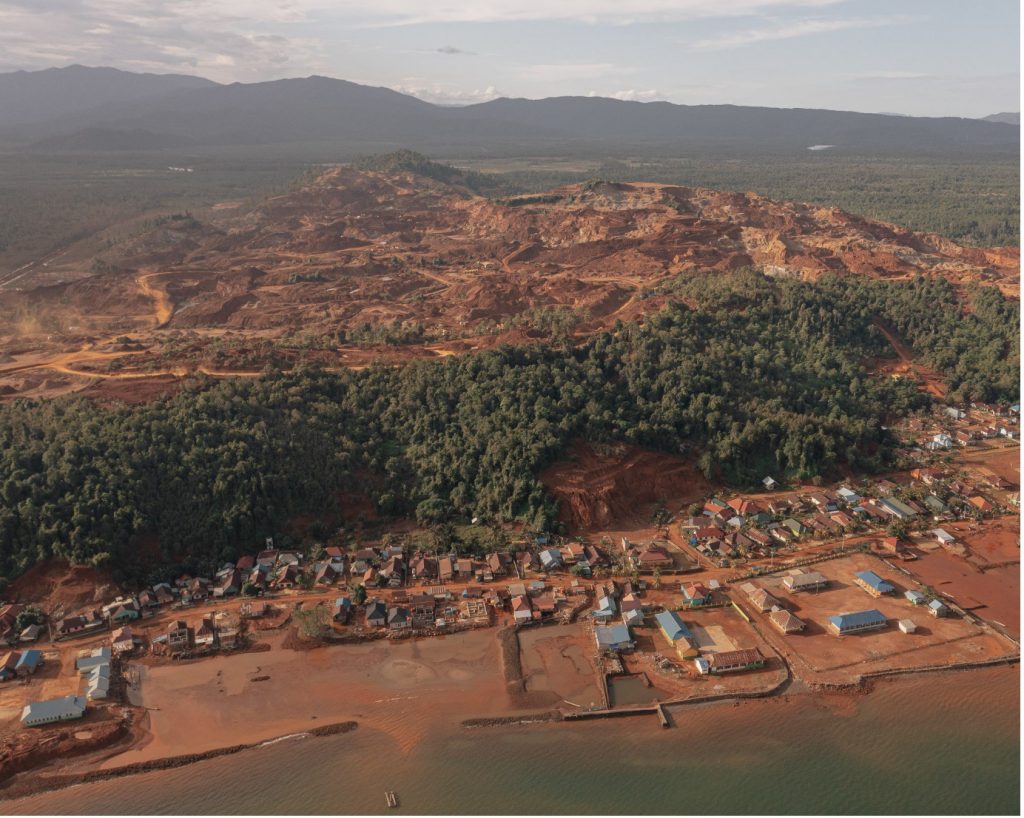Image: Indonesia Nickle Industry by Muhammad Fadli
Nickel is a metallic element with a silvery-white, shiny appearance. It is the fifth-most common element on Earth and occurs extensively in its crust and core. The world’s nickel resources are currently estimated at almost 350 million tons. Nickel-containing ores are presently mined in more than 25 countries worldwide. The Asia Pacific region accounts for over 70% of global nickel production. The biggest nickel producers are Indonesia, the Philippines, Russia, Australia, and Canada. [1]
Nickel is an essential metal in modern infrastructure and technology, with significant uses in stainless steel (∼ 58%), nickel-based alloys (∼ 14%), casting and alloy steels (∼ 9%), electroplating (∼ 9%) and rechargeable batteries (∼ 5%). [2] With nickel in such high demand for batteries and cleaner energy infrastructure, it’s no wonder that global nickel demand is expected to outweigh supply by 2024. The scarcity of high-grade nickel sulfide deposits and the carbon intensity of mining them has also incentivized the exploration of new metal harvesting methods. [3]
Nickel can be produced from either oxidic (laterite) or sulphidic ores, the mineralogy (and ore grade) of each influencing energy demand during the mining and subsequent processing stages. Mining oxidic ore deposits are generally less energy intensive, but downstream processing of these ores requires significantly higher energy consumption. The ore deposit’s location, depth, and shape can also considerably impact the energy demand. Deposits in remote or relatively inaccessible areas require more infrastructure, specialized equipment, and greater energy consumption. Location geography and geology also dictate energy sources. [4]
The extraction and production of nickel can have significant environmental impacts, including air and water pollution, soil degradation, and wildlife habitat destruction. Emissions from the smelting and refining nickel-rich ores can release harmful substances into the air, including sulfur dioxide, nitrogen oxides, and particulate matter. The release of toxic chemicals, such as heavy metals, into nearby water sources can devastate aquatic life and the health of local communities that rely on these water sources for drinking, irrigation, and other purposes. Large-scale mining operations can destroy wildlife habitats, deforestation, and fragmentation of ecosystems. The loss of habitats can have severe consequences for local biodiversity and result in the displacement of local communities who depend on these habitats for their livelihoods. [5]
In Indonesia, nickel is produced from opencast mines. Opencast nickel mining is an intensive process that significantly impacts tropical rainforests, affecting indigenous vegetation and soil fertility. [6] Dozens of nickel processing plants exist in Sulawesi, one of the world’s largest islands in Indonesia, with many more projects have been announced. The Sulawesi coastline has suffered from environmental destruction due to the nickel mines. Contaminated soil from nickel mines runs off the hills when it rains, turning the coastal waters deep red. [7] The mine in Morosi District, South East Sulawesi, clearly impacted the socio-economic condition of the villagers within the regency [8]. Nickel mining also threatens the health and environment of Obi Island’s people, Kawasi, North Maluku, Indonesia. The mines and refineries at Kawasi dump their waste products directly into the sea in a practice known as deep sea tailing placement (DSTP). DSTP is a cheaper waste disposal alternative than tailing dams on land. Kawasi fishermen report that the catches have decreased considerably, and they have to sail further away to find fisheries to sustain their families. In addition, scientists have also reported dangerous levels of heavy metals in local fish and shells often consumed by villagers. [9] These are just a few examples in Indonesia of poor practices of nickel mines that had considerable effects on the environmental and social aspects.
Can the developers, miners, and relevant stakeholders make collaborative and cooperative efforts to deal with the impacts of nickel mines? Note that the impacts might last longer than the project’s lifetime. Hence, the developer must commit to sustaining good practices pre- and post-mining according to local and international policies, standards, or guidelines. The authority should also commit to strengthening the local regulations, strictly carrying out law enforcement, and continuously monitoring the impacts of the mines. The impacted community should be given equal opportunity to address complaints and to propose a practical mitigation and measure to their concerns and needs.
Ref:
[1] “The life of Ni”, Nickle Institute, retrieved online from https://nickelinstitute.org/media/1190/thelifeofni.pdf (Aug, 2023)
[2] Mudd, G.M, 2010, “Global trends and environmental issues in nickel mining: Sulfides versus laterites”, Ore Geology Reviews, Volume 38, Issues 1–2, October 2010, Pages 9-26, retrieved online from https://www.sciencedirect.com/science/article/abs/pii/S0169136810000569 (Aug, 2023)
[3] Conte, N, 2021, “The World’s Largest Nickel Mining Companies”, retrieved from https://elements.visualcapitalist.com/the-worlds-largest-nickel-mining-companies/
[4] Boonzaier, S, et al., 2016, “Life cycle assessment of nickel products”, Int J Life Cycle Assess (2016) 21:1559–1572, DOI 10.1007/s11367-016-1085-x, retrieved online from https://link.springer.com/article/10.1007/s11367-016-1085-x
[5] Shout Learning, “The Environmental Impacts of Nickel Mining and Production”, retrieved from https://shoutlearning.org/the-environmental-impacts-of-nickel-mining-and-production.html#:~:text=Emissions%20from%20the%20smelting%20and,contribute%20to%20global%20climate%20change.
[6] Tawaraya et al., 2020, “The Impact of Nickel Mining on Soil Properties and Growth of Two Fast-Growing Tropical Trees Species.”, Hindawi, International Journal of Forestry Research Volume 2020, Article ID 8837590, 9 pages, retrieved online from https://downloads.hindawi.com/journals/ijfr/2020/8837590.pdf?
[7] Brown, H, 2023, “‘The trees were all gone’: Indonesia’s nickel mines reveal the dark side of our electric future”, retrieved from https://www.euronews.com/green/2023/03/15/the-trees-were-all-gone-indonesias-nickel-mines-reveal-the-dark-side-of-our-electric-futur
[8] Masri, M et al., 2020, “The Impact of Nickel Management on Community Socio-Economic Conditions in Morosi District Konawe Regency”, Indonesian Journal of Social and Environmental Issue, ISSN: 2722-1369 (Online), Volume 1, Issue 1 (April 2020): 1-4, retrieved online from https://ojs.literacyinstitute.org/index.php/ijsei
[9] Environmental Justice Atlas, 2015, “Nickel rush threatens the health and environment of Obi Island’s people, Indonesia”, retrieved online from https://ejatlas.org/conflict/local-health-threatened-by-nickel-mining-in-obi-island-indonesia
Author: Hendra Winastu, Main Associate of SOLEN – IPC Council Coordinator
Editor: Moe Thazin Shwe, Main Associate of SOLEN – IPC Council Coordinator
Date: 23/8/2023
Article No: SOLEN-IPC-0024



 Tiếng Việt
Tiếng Việt 日本語
日本語
Pingback: Landfills in ASEAN Countries - Solen
Pingback: ASEAN諸国の埋立地 - Solen